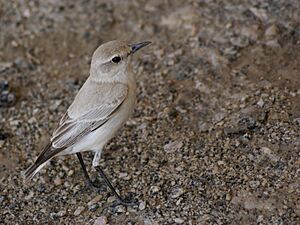Tractrac chat facts for kids
Quick facts for kids Tractrac chat |
|
|---|---|
 |
|
| In the Namib Naukluft, Namibia | |
| Conservation status | |
| Scientific classification | |
| Genus: |
Emarginata
|
| Species: |
tractrac
|
| Synonyms | |
|
Cercomela tractrac |
|
The tractrac chat (Emarginata tractrac) is a small bird that sings, belonging to the Old World flycatcher family called Muscicapidae. It's a common bird that lives all year round in southern Angola, western Namibia, and western South Africa.
You can find the tractrac chat in places like the Karoo desert, dry scrublands, sandy dunes, and flat areas with gravel.
Contents
How the Tractrac Chat Got Its Name (Taxonomy)
The tractrac chat was first drawn and described by a French nature expert named François Levaillant in 1805. He called the bird "Le tractrac" because its call sounded like "tractrac."
Later, in 1817, an English publisher named John Wilkes gave the bird its first official scientific name, Motacilla tractrac. Over time, scientists studied birds more closely. They used molecular phylogenetic studies, which look at a bird's DNA. These studies showed that the tractrac chat belonged in a different group, so it was moved to its current genus called Emarginata.
There are 5 different types, or subspecies, of the tractrac chat:
- E. t. hoeschi – found in southwestern Angola and northwestern Namibia.
- E. t. albicans – found in western Namibia.
- E. t. barlowi – found in southern Namibia.
- E. t. nebulosa – found in southwestern Namibia.
- E. t. tractrac – found in western South Africa.
What the Tractrac Chat Looks Like (Description)
The tractrac chat is a small bird, about 14–15 cm long, which is roughly the length of a pen. It weighs about 20 grams, which is like two pencils.
Its tail is white with a dark, upside-down "T" shape at the very end. This pattern is similar to what you might see on some wheatear birds. The bird has a short, straight, black beak, and its legs and feet are also black. It has dark eyes.
The tractrac chats living in the Namib Desert, especially on sandy dunes and near the coast, have very light, almost white feathers. Their wings are grey, and the "T" on their tail is also grey. The chats found in the south-eastern areas, on gravel plains, have brown feathers on their backs. Their flight feathers and tail markings are blackish, and their undersides are white. Both male and female tractrac chats look very similar. Young birds, called juveniles, look a bit more spotty than the adults.
This bird is smaller than the Karoo chat. It is also lighter and greyer than the Familiar chat and sickle-winged chats.
The tractrac chat has a soft, fast song that sounds like "tactac." When it wants to protect its territory, it makes a loud, chattering call.
Tractrac Chat Behavior and Life Cycle
The tractrac chat builds a nest shaped like a cup. It uses straw and leaves to make its nest on the ground, often hidden under a bush or shrub. The female bird lays two to three red eggs. These birds are monogamous, which means they usually stay with the same partner for their whole lives.
You will usually see tractrac chats by themselves or in pairs. They look for food on the ground, mostly eating insects. Their diet includes butterflies, bees, wasps, locusts, and ants. They often catch their prey by flying up quickly for a short moment.
Protecting the Tractrac Chat (Conservation Status)
The tractrac chat is a common bird and lives across a very large area. This area is estimated to be about 1,000,000 square kilometers! Scientists believe there are many of these birds.
The number of tractrac chats is not decreasing quickly. Because of this, the species is considered to be of "Least Concern" by the IUCN Red List. This means they are not currently at risk of disappearing.


